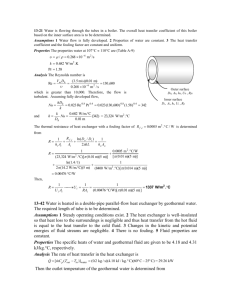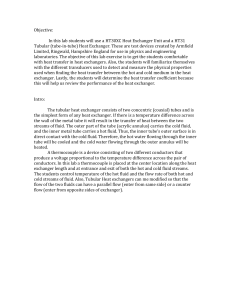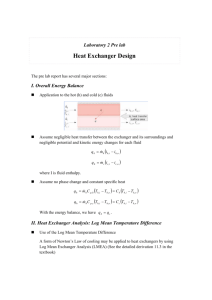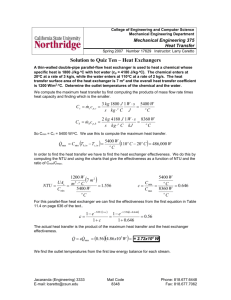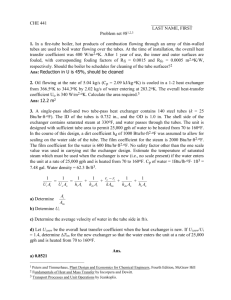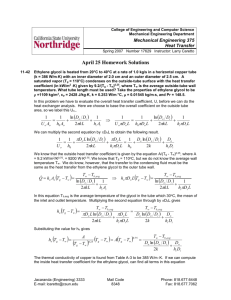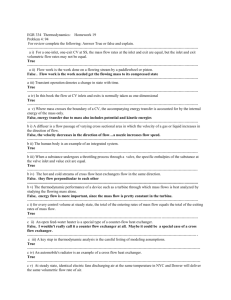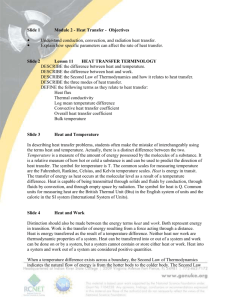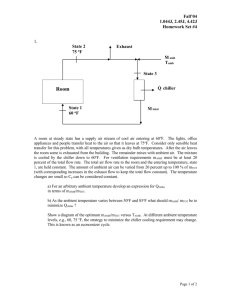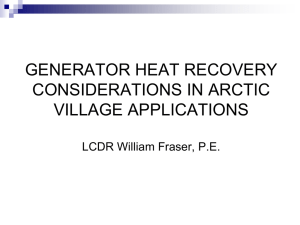13-26E Water is cooled by air in a cross
advertisement
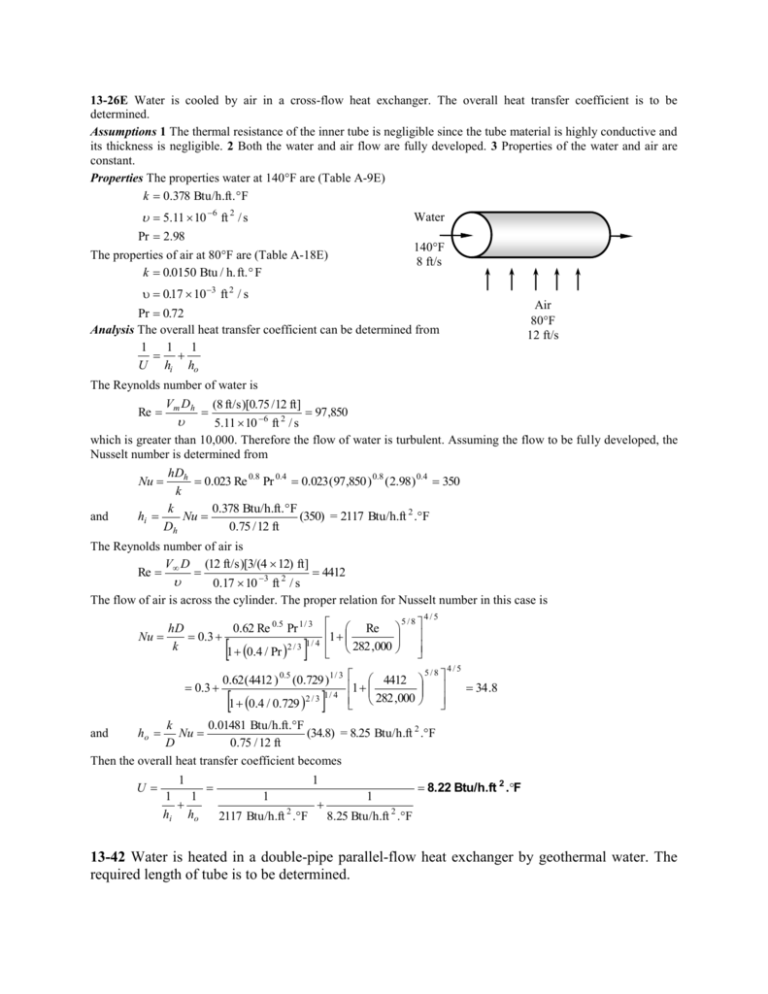
13-26E Water is cooled by air in a cross-flow heat exchanger. The overall heat transfer coefficient is to be determined. Assumptions 1 The thermal resistance of the inner tube is negligible since the tube material is highly conductive and its thickness is negligible. 2 Both the water and air flow are fully developed. 3 Properties of the water and air are constant. Properties The properties water at 140F are (Table A-9E) k 0.378 Btu/h.ft. F 5.11 10 6 ft 2 / s Water Pr 2.98 The properties of air at 80F are (Table A-18E) k 0.0150 Btu / h.ft. F 140F 8 ft/s 017 . 10 3 ft 2 / s Air 80F 12 ft/s Pr 0.72 Analysis The overall heat transfer coefficient can be determined from 1 1 1 U hi ho The Reynolds number of water is V D (8 ft/s)[0.75 /12 ft] Re m h 97 ,850 5.11 10 6 ft 2 / s which is greater than 10,000. Therefore the flow of water is turbulent. Assuming the flow to be fully developed, the Nusselt number is determined from hDh Nu 0.023 Re 0.8 Pr 0.4 0.023 (97,850 ) 0.8 (2.98) 0.4 350 k k 0.378 Btu/h.ft.F and hi Nu (350) = 2117 Btu/h.ft 2 .F Dh 0.75 / 12 ft The Reynolds number of air is V D (12 ft/s)[3/(4 12) ft] Re 4412 0.17 10 3 ft 2 / s The flow of air is across the cylinder. The proper relation for Nusselt number in this case is hD 0.62 Re 0.5 Pr 1 / 3 Nu 0.3 1/ 4 k 1 0.4 / Pr 2 / 3 Re 5 / 8 1 282 ,000 4/5 5/8 0.62 (4412 ) 0.5 (0.729 )1 / 3 4412 1 0.3 2 / 3 1/ 4 282 , 000 1 0.4 / 0.729 4/5 34 .8 k 0.01481 Btu/h.ft.F Nu (34.8) = 8.25 Btu/h.ft 2 .F D 0.75 / 12 ft Then the overall heat transfer coefficient becomes and ho U 1 1 8.22 Btu/h.ft 2 .F 1 1 1 1 hi ho 2117 Btu/h.ft 2 .F 8.25 Btu/h.ft 2 .F 13-42 Water is heated in a double-pipe parallel-flow heat exchanger by geothermal water. The required length of tube is to be determined. Assumptions 1 Steady operating conditions exist. 2 The heat exchanger is well-insulated so that heat loss to the surroundings is negligible and thus heat transfer from the hot fluid is equal to the heat transfer to the cold fluid. 3 Changes in the kinetic and potential energies of fluid streams are negligible. 4 There is no fouling. 5 Fluid properties are constant. Properties The specific heats of water and geothermal fluid are given to be 4.18 and 4.31 kJ/kg.C, respectively. Analysis The rate of heat transfer in the heat exchanger is p (Tout Tin )]water (0.2 kg / s)(4.18 kJ / kg. C)(60 C 25 C) = 29.26 kW Q [mC Then the outlet temperature of the geothermal water is determined from Q 29.26 kW C p (Tin Tout )] geot.water Q [m Tout Tin 140 C 117 .4C Cp m (0.3 kg/s)(4.3 1 kJ/kg. C) The logarithmic mean temperature difference is T1 Th,in Tc,in 140 C 25 C = 115 C 60 C T2 Th,out Tc,out 117.4 C 60 C = 57.4 C and Tlm T1 T2 115 57.4 82.9 C ln( T1 / T2 ) ln(115 / 57.4) Brine 140C The surface area of the heat exchanger is determined from Q UA s Tlm As Q 29 .26 kW 0.642 m 2 UTlm (0.55 kW/m 2 )(82 .9C) Water 25C Then the length of the tube required becomes As DL L As 0.642 m 2 25.5 m D (0.008 m) 13-81C The value of effectiveness increases slowly with a large values of NTU (usually larger than 3). Therefore, doubling the size of the heat exchanger will not save much energy in this case since the increase in the effectiveness will be very small. 13-84 Hot oil is to be cooled by water in a heat exchanger. The mass flow rates and the inlet temperatures are given. The rate of heat transfer and the outlet temperatures are to be determined. Assumptions 1 Steady operating conditions exist. 2 The heat exchanger is well-insulated so that heat loss to the surroundings is negligible and thus heat transfer from the hot fluid is equal to the heat transfer to the cold fluid. 3 Changes in the kinetic and potential energies of fluid streams are negligible. 4 The thickness of the tube is negligible since it is thin-walled. 5 The overall heat transfer coefficient is constant and uniform. Properties The specific heats of the water and oil are given to be 4.18 and 2.2 kJ/kg.C, respectively. Analysis The heat capacity rates of the hot and cold fluids are Oil 160C h C ph (0.2 kg / s)(2200 J / kg. C) 440 W/ C Ch m 0.2 kg/s c C pc (0.1 kg / s)(4180 J / kg. C) 418 W/ C Cc m Therefore, Cmin Cc 418 W/ C and C Cmin 418 0.95 Cmax 440 Then the maximum heat transfer rate becomes Water 18C 0.1 kg/s (12 tube passes) Q max Cmin (Th,in Tc,in ) (418 W/ C)(160 C -18 C) 59.36 kW The heat transfer surface area is As n(DL) (12)( )(0.018m)(3m) 2.04 m 2 The NTU of this heat exchanger is NTU UA s (340 W/m 2 .C) (2.04 m 2 ) 1.659 C min 418 W/C Then the effectiveness of this heat exchanger corresponding to C = 0.95 and NTU = 1.659 is determined from Fig. 13-26d to be = 0.61 Then the actual rate of heat transfer becomes Q Q (0.61)(59.36 kW) 36.2 kW max Finally, the outlet temperatures of the cold and hot fluid streams are determined to be Q 36 .2 kW Q C c (Tc,out Tc,in ) Tc,out Tc,in 18 C + 104.6 C Cc 0.418 kW / C Q 36 .2 kW Q C h (Th,in Th,out ) Th,out Th,in 160 C 77.7 C Ch 0.44 kW/ C 13-109 Cooling water is used to condense the steam in a power plant. The total length of the tubes required in the condenser is to be determined and a suitable HX type is to be proposed. Assumptions 1 Steady operating conditions exist. 2 The heat exchanger is well-insulated so that heat loss to the surroundings is negligible and thus heat transfer from the hot fluid is equal to the heat transfer to the cold fluid. 3 Changes in the kinetic and potential energies of fluid streams are negligible. 4 The overall heat transfer coefficient is constant and uniform. Properties The specific heat of the water is given to be 4.18 kJ/kg.C. The heat of condensation of steam at 30C is given to be 2430 kJ/kg. Analysis The temperature differences between the steam and the water at the two ends of condenser are Steam 30C 26C T1 Th,in Tc,out 30 C 26 C = 4 C T2 Th,out Tc,in 30 C 18 C = 12 C 18C and the logarithmic mean temperature difference is Tlm T1 T2 4 12 7.28 C ln( T1 / T2 ) ln 4/12 The heat transfer surface area is Q = UA s Tlm As Q 500 10 6 W = = 1.96 10 4 m 2 UTlm (3500 W/m 2 .C)( 7.28 C) The total length of the tubes required in this condenser then becomes As DL L As 1.96 10 4 m 2 3.123 10 5 m 312.3 km D (0.02 m) A multi-pass shell-and-tube heat exchanger is suitable in this case. Water 30C
